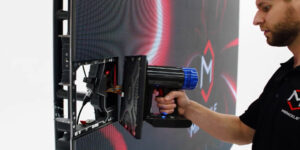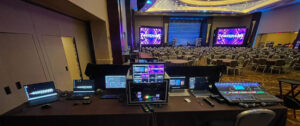Due to wear and tear, periodic maintenance is required for all technology. If this procedure is not performed, we might run into difficulties If the item is not reaching its maximum lifespan. This is also true of LED display panels.
Why is it necessary to perform this task periodically?
The estimated lifespan of an LED wall ranges between 60,000 and 100,000 hours, which is crucial information to have. That’s 45 years based on an average of six hours per day. Without consistent and appropriate maintenance, however, the lifespan of your equipment could be significantly reduced.
Here are the most important reasons to perform maintenance both ways:
1. Correct and Proper Installation

Installation is a complex procedure that requires the expertise of a professional. Additionally, the type of maintenance that will be performed after installation must be considered.
It is essential to find a reliable provider. We recommend LED panels that have a sturdy aluminum truss that is welded on both sides.
2. Stay Current with the Status of Your LED Wall
Maintenance is recommended twice a year. This would require two revisions every six months to assess its condition. Through this examination, it is possible to determine which restoration processes need to be implemented.
Here, we evaluate the software and hardware efficacy of our equipment, for front and rear:
- Its capacity to operate between 80 and 100% luminance
- Ability to perform multiple brightness patterns without difficulty
- Each pixel’s condition and no panels are damaged
- Humidity levels in the instruments
- The internal wiring and condition of the panel’s interiorKeep in mind if your display is located in a humid environment, you must be especially cautious when turning it on.
If we have not used our screen panel for three days, we can preheat it by utilizing only 30-50% of its maximum brightness. Preheating is dependent on how long the device has been inactive and its relative humidity.
3. Ensure Proper Configuration

Typically, the intensity in which color ranges are portrayed can be adjusted. This is modifiable based on the user’s preferences, but setting all of them to the maximum settings is risky as it can result in overheating.
The screen’s luminance must be adjusted to the environment. If we are in a well-lit room, utilizing its total capacity is unnecessary.
In general, these devices have an automatic adaptable configuration. If not available, you can adjust the brightness until the image appears crisp. Which is neither too dazzling to prevent burning nor too opaque to prevent the visibility of images.
If the room is already illuminated and we use an extremely bright configuration, the equipment may overheat.
4. Dust Prevention
Depending on the level of protection and the surrounding environment, dust can penetrate modular display panels. This primarily affects outdoor displays, directly applicable in rear maintenance in which these gears are more susceptible to corrosive agents.
Dust particles can easily penetrate the interior and accumulate in vital areas, impeding performance.
Without routine maintenance, dust accumulation on fans can cause scalding and permanent damage. In addition, dust particles can carry moisture with them, which reduces the brightness of each panel.
It is possible to remove dust with a gentle brush or vacuum cleaner, but this delicate task is best left to the experts, particularly due to front and rear maintenance systems that must be built in according to the placement and usage of the screens.
5. Protect It From Humidity
Humidity is another environmental factor that reduces its functionality. At the time of installation, it is crucial to determine whether the area is dried on both sides.
Whether our panel is outside or inside a building will have a significant effect on the humidity level. Due to rainy and humid seasons, the LED panel will require continuous drying if it is placed outdoors. So that we can avoid moisture-related brief circuits.
Typically, these are intended for advertising on busy highways, at stadiums, at concerts, and in many other places where visibility is enhanced.
When dealing with a humid environment it is important to monitor the conditions of the internal components of the LED screens to keep them performing properly.
6. Verify The Status of the LED Screen Circuitry

Once it is determined that an internal circuit has ceased to function, it must be repaired.
However, it is not advised that non-professionals attempt to perform this procedure. This can result in a brief circuit and possible bodily harm, as well as compromise the equipment’s integrity. In addition, each panel is maintained based on its installation type, which is something only a trained professional can recognize.
7. Monitor the Voltage Regulator and Protector
Variable voltage can have devastating effects on our equipment. This primarily applies to energy-hungry electronics.
It is crucial that a professional performs periodic inspections and examines the condition of our protectors. If they do not function as a voltage overload shield, it could compromise the overall safety of our panels.
The 2.6mm pitch panel LEDs, for instance, are rated at 100 to 240V. Therefore, a voltage protector suited to that current must be utilized and its status must be continuously monitored from the rear.

8. Preserving the Operation of the led display Panel in the Case of Water Damage
In addition to other factors, such as metal particles, water is a significant concern for indoor LED display panels. If the internal component is wet, the initial step is to not switch on the equipment as it can compromise the whole set.
If this happens it is important to act fast and call an expert as soon as possible to restore and preserve the LED panels.
On the other hand, outdoor LED walls are resistant to humidity and precipitation. These items are designed specifically for these climates Nevertheless, it is still important to have professionals work on full maintenance settings to ensure the LED panel is working properly and effectively.
9. Know the Recommended Temperature for Your LED Wall
These varieties of devices are temperature-sensitive. In the same way that humidity has a significant impact on its operation, excessive temperatures can render it inoperable.
To determine the equipment’s reaction to a given environment and the potential solutions in the event of a problem, the advice of an expert will be indispensable. For instance, installing improved ventilation in a confined space or relocating it.
The maximum acceptable temperature for a fully functional screen is 50 degrees. However, if ventilation is inadequate, the temperature can exceed 80 degrees. If this temperature is maintained for an extended period, it will be rapidly damaged.
Temperatures may be higher than normal because of the humidity. Indoor exhibitions would benefit from the installation of air conditioning under these conditions.
A second factor is the accumulation of grime within the led wall. This can be remedied by cleansing the interior, using a maintenance channel, which professionals often mount when installing the screens.
10. Consider Allowing the Professionals Handle This
You may have some knowledge of their operation and maintenance. But when related to front and rear. Extensive parameters are required to guarantee the care and longevity of a project, which necessitates the assistance of a company with a demonstrated track record. Such an ally is indispensable for any endeavor that aims to endure for decades. This is why we recommend Led Market, which has the necessary expertise to ensure that your device is always protected and functioning correctly
